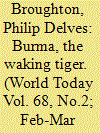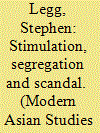| Srl | Item |
| 1 |
ID:
123163


|
|
|
|
|
| Publication |
2012.
|
| Summary/Abstract |
Philip Delves Broughton grew up hearing of a glorious Burmese past that had been lost forever. but as the returns to the land of his mother, he sees singn for hope in a country rich in potential
|
|
|
|
|
|
|
|
|
|
|
|
|
|
|
|
| 2 |
ID:
108374


|
|
|
| 3 |
ID:
115284


|
|
|
|
|
| Publication |
2012.
|
| Summary/Abstract |
This paper explores the regulation of prostitution in colonial India between the abolition of the Indian Contagious Diseases Act in 1888 and the passing of the first Suppression of Immoral Traffic Act in 1923. It challenges the commonly held assumption that prostitutes naturally segregated themselves in Indian cities, and shows that this was a policy advocated by the Government of India. The object was to prevent the military visiting these segregated areas, in the absence of effective Cantonment Regulations for registering, inspecting, and treating prostitutes. The central government stimulated provincial segregation through expressing its desires via demi-official memoranda and confidential correspondence, to which Rangoon and Bombay responded most willingly. The second half of the paper explores the conditions, in both India and Ceylon, that made these segregated areas into scandalous sites in the early twentieth century. It situates the brothel amongst changing beliefs that they: increased rather than decreased incidents of homosexuality; stimulated trafficking in women and children; and encouraged the spread of scandalous white prostitutes 'up-country', beyond their tolerated location in coastal cosmopolitan ports. Taken alongside demands that the state support social reform in the early twentieth century, segregation provided the tipping point for the shift towards suppression from 1917 onwards. It also illustrates the scalar shifts in which central-local relations, and relations between provinces, in government were being negotiated in advance of the dyarchy system formalized in 1919.
|
|
|
|
|
|
|
|
|
|
|
|
|
|
|
|
| 4 |
ID:
118899


|
|
|
|
|
| Publication |
2012.
|
| Summary/Abstract |
Around the turn of the twentieth century, electric tramways made their appearance in the cities of Asia, but despite being a universal technology, and despite the considerable impact they had upon life in these cities, the history of tramways in Asia has hardly ever been studied. Trams, wherever they ran, mobilized the urban population to a degree unseen before-their track network could restructure the urban topography and re-evaluate its segments, as independent villages became suburbs and residential quarters rose or fell in status, and add to the segregation of workplaces and residential areas. The two cities of Singapore and Rangoon, which have been selected because of their comparability, provide two contrasting examples of how trams functioned and eventually failed in an Asian urban environment.
|
|
|
|
|
|
|
|
|
|
|
|
|
|
|
|